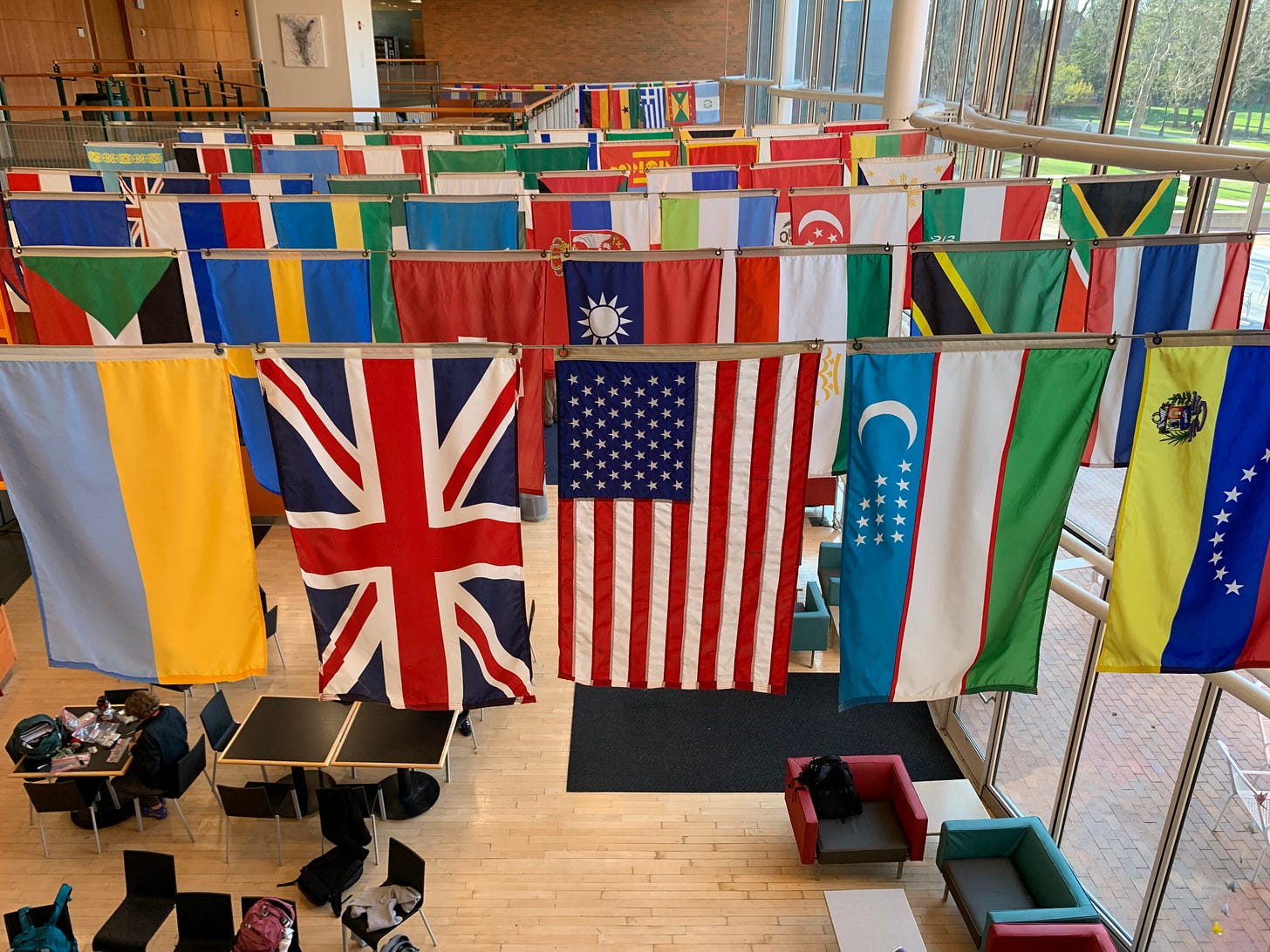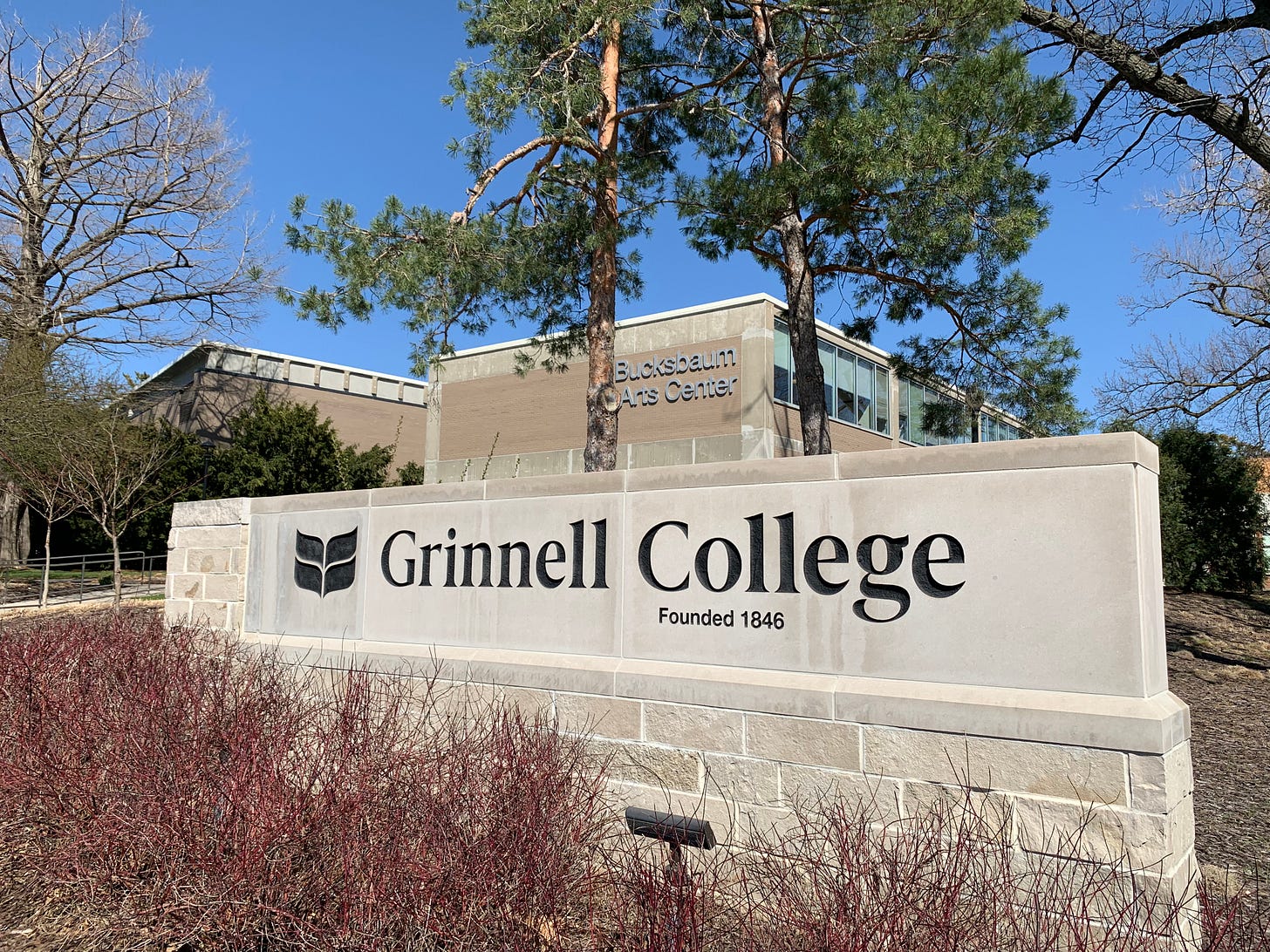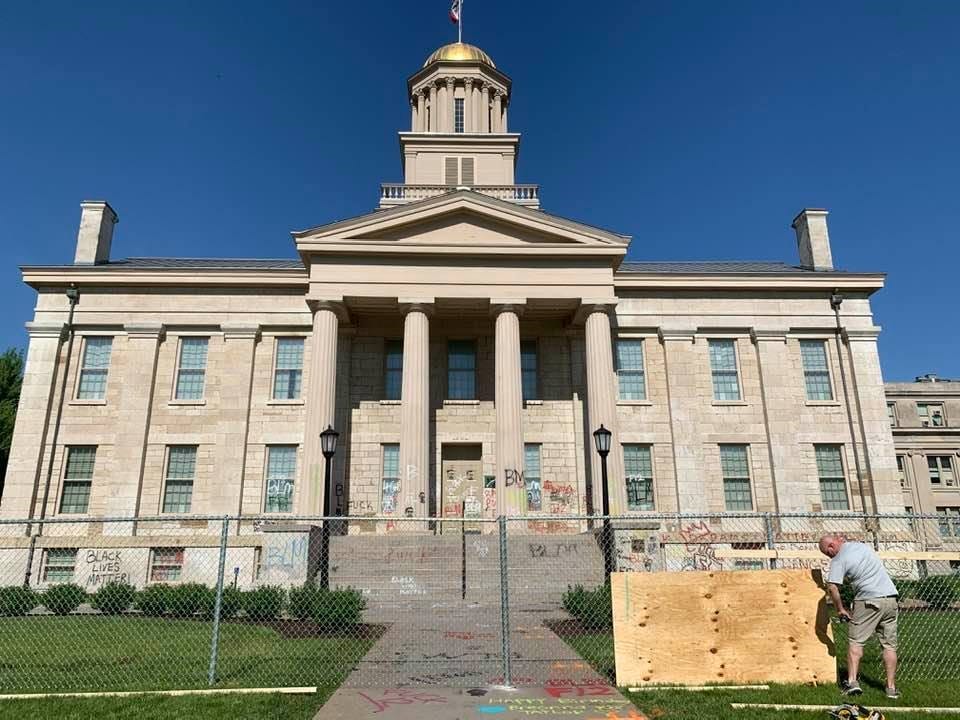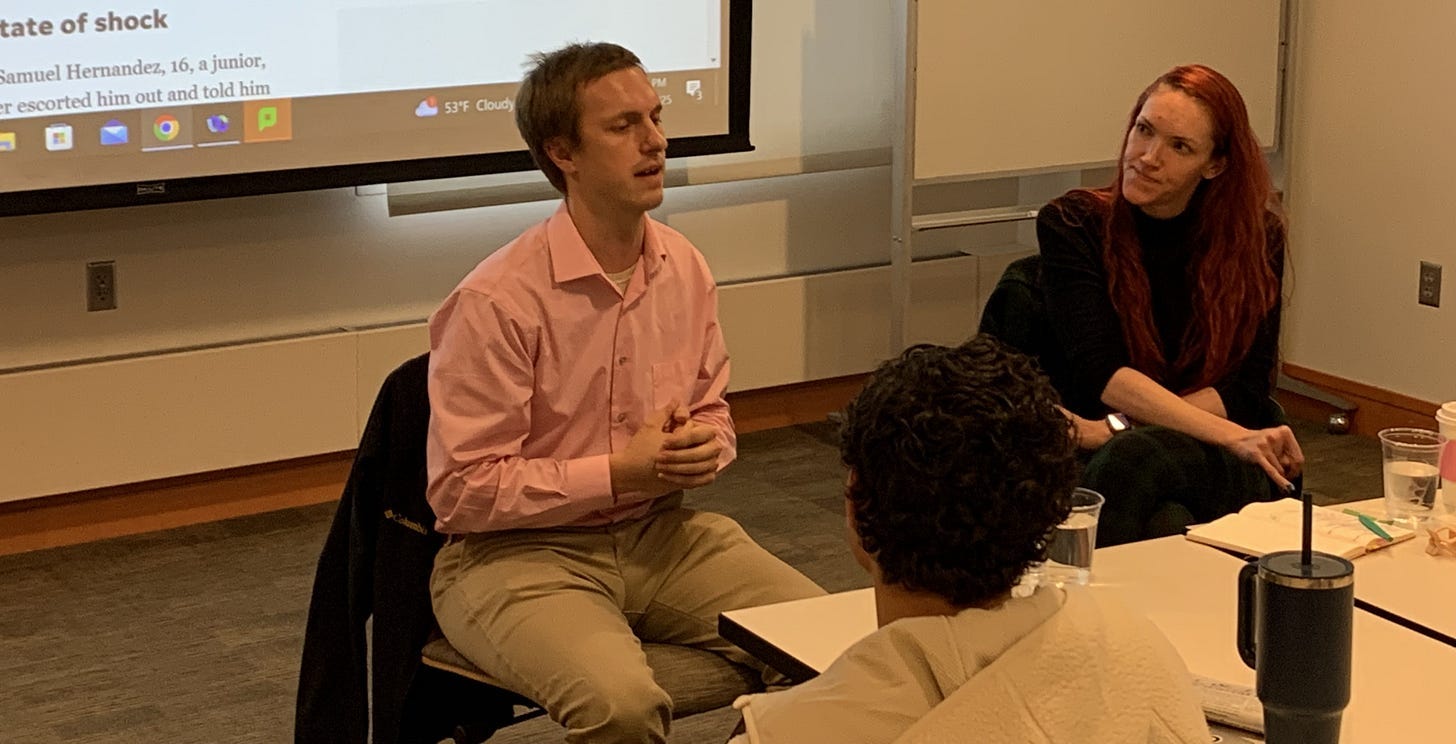Why we need to support college student journalists working under threats
These reporters have better access and understanding than outside journalist do when it comes to public policies that affect their education
Grinnell College’s Gallery of Flags above the campus’s Spencer Grill represent more than 60 countries sending students to the mid-state liberal arts college. Students from some of those countries are journalists at the college’s Scarlet & Black newspaper. Photo taken on April 7, 2025. (Photo by Lyle Muller)
Student-run newspapers at colleges across the country are under fire, which is not news in other years, but is extraordinary at this time in U.S. history because of the political open season on higher education that exists. This should concern you.
Colleges and universities, usually via their student government bodies, are trying to cut funding for several of these papers. Kansas University’s student government proposed earlier this year cutting funding 80% and requested more journalism school funding for The University Daily Kansan. That proposal failed to get support but student government later dropped funding by about 60%.
Meanwhile, signs of political pressure on the papers exist while the Trump administration carries out open season on higher education.
College student newspapers across the country are important for several reasons but two stand out. One is the basic need to report accurately what is happening to students, faculty, staff, alumni, and anyone else with a stake in a college or university when attention-grabbing events and trends bring outside news organizations and accompanying political responses to campus. The other is because of the access these papers have to cover colleges and universities that are coming under fire for things like teaching critical thinking and including voices that otherwise are marginalized or ignored.
Student journalists living college life day-after-day have better access than outsiders to the impact of laws, such as those singling out trans and non-binary people for civil rights protection, restricting inclusion and equity, and threatening funding for higher education institutions. These student journalists do not swoop onto campus, bag a story, and leave. They have to face the people they write about each day and be accountable for their stories.
Yet, Penn State University, a publicly supported institution that operates as a private college, removed the respected Daily Collegian’s news racks last fall after the paper sold spots to the Kamala Harris campaign for their ads. Political advertising was not allowed on news racks, the college told the students. In Vermont, Norwich University, a private military school, suspended The Guidon for the entire fall 2024 semester for what a lawsuit later filed by the paper’s adviser says was retribution for negative coverage about the school. That coverage included an alleged sexual assault on campus in April 2024.
All this comes as college and university campuses are skittish about how the Trump administration is going to strike at them for things Trump and his followers do not like. It is working. Threats to withhold funding have places like Columbia University giving in to Trump efforts to identify demonstrators the administration wants to punish, taking stronger oversight of student groups, and hiring 36 special campus police to make arrests when necessary – read that to mean during protests.
Good, informed reporting is needed on these matters and student newspapers have shown they can do it, despite efforts to thwart reporting news. But, we have to shift collegiate journalism training in order to reflect the current world. In this world, students covered in campus newspapers during any political activity fear that the coverage puts them at risk for harassment, or, for international students in this country legally, of deportation. Grinnell College, in the middle of Iowa, has students carrying passports from more than 60 countries.
Exhibit A for deportations is Rümeysa Öztürk, the Tufts University graduate student from Turkey whose infraction appears to criticizing Tufts administrators in a student newspaper opinion piece in a dispute over divesting Tufts funds from companies with ties to Israel.
Chilling reactions feed off each other. Students stop expressing opinions in their college paper. College papers start questioning whether or not they should identify people who call in public places for changes in public policy. Keep in mind that withholding public information in such a circumstance would alter thereby alter the factual depiction of a public event.
Here’s one to consider: College administrators worried about showing up on the government’s radar pressure student newspapers to censor sensitive information, not only to protect their students but to protect themselves and the college or university.
Imagine wondering 50 years from now why no one opposed Trump administration moves if protest news were eliminated from college newspaper websites in order to protect participants and colleges.
This kind of thinking used to be wild, fear-mongering nonsense. Not anymore.
Grinnell College entrance sign on April 7, 2025. (Photo by Lyle Muller)
Emotional issues add to the concerns
A few years ago, in 2021, an unhappy Grinnell College Student Government Association officer became upset with The Scarlet & Black for identifying her in coverage of a public rally, along with other grievances. Never mind her public position, that she participated in a public rally in a public place. She threw a bunch of papers outside into the rain to show her anger.
That same year, Student Government Association members interrupted production of the newspaper in a bid to keep the paper from reporting about a suspended Grinnell College faculty member, plus got their facts wrong when smearing the reporter’s reputation and their version of how she got the story.
I got to experience the Grinnell squabbles as The Scarlet & Black’s professional adviser. The S&B’s journalists are lucky in many regards. The College president, communications and marketing office, and student affairs office they deal support the paper’s mission and students. Also, the paper has a good relationship now with the student government.
Still, some students are wary of how the paper covers people in their ethnic groups. Work is needed to build trusting relationships. At least they talk about it, though, instead of trying to stop the paper. On the positive side, people more often view the opinions page this school year as a place where they believe they can share ideas.
Covering racial matters particularly brings tension, usually because students running newspapers are not in tune much with people outside or the newsroom culture. The American Association of University Professors (AAUP) reported pressure from left-wing groups but also college administrators in 2016 over how college newspapers should cover the Black Lives Matter movement. The Pew Research Center reported in November 2023 about continued, mounting pressure.
In addition to working with Grinnell College students, I was the Ethics & Politics coach at the University of Iowa’s highly regarded The Daily Iowan when Black Lives Matter demonstrations heated up nationwide in 2020. This was in the aftermath of George Floyd’s murder at the hands of a Minneapolis police officer, and The DI covered the response in Iowa City.
The DI journalists were surprised to learn that demonstrators whom they thought would be friendly college student peers handed them a healthy dose of hostility and demands on what they should or should not do and how they should cover the story. Virtually all of The DI reporters, photographers, videographers and editors had never seen a public demonstration the likes of this, let alone cover one for a news outlet. We coaches held several sessions with the journalists and helped them write a policy for covering public demonstrations.
The primary advice for our fledging journalists was and is:
Have a tough skin.
You have a job to do, and it is of great public service.
The University of Iowa’s Old Capitol, decorated with graffiti on June 6, 2020, after a demonstration to protest the murder of a Minneapolis Black man, George Floyd. (Photo by Lyle Muller)
State issues show it’s not just federal and social issues
The Iowa Legislature was considering until April 7 a bill that called for banning diversity, equity and inclusion activities at not only public universities but also private colleges that want to accept students that receive Iowa Tuition Grant money. Private colleges were removed from the bill with a late session amendment but the bill still has a ban on diversity, equity and inclusion offices at public institutions.
Sounds like a reason to have strong college student journalism.
To be clear, some pressure student journalists feel can and should be productive. Reporting the truth accurately and in an ethical manner produces pressure to do right. Plus, these students are adults. They might as well learn early how to be criticized just like the long-time pros.
Yet, researchers at Northeastern University School of Journalism reported in 2022 that criticism tossed at 218 surveyed student journalists from U.S. colleges across the country over the previous year extended to online harassment in many instances. “This research convinced us that teaching student journalists about on-the-job harassment is a crucial step in reshaping journalism’s overall professional culture into something more inclusive, accessible and supportive of new practitioners,” the researchers wrote for Poynter.
The abuse was so bad, the researchers said, that it could deter women and people of color from being journalists at a time the profession needs to be more diverse.
Reporting uncomfortable stories
Push-back on student journalists also comes from an uncomfortable story. It happened at Grinnell College this school year when The Scarlet & Black started reporting an alleged assault on a Black, gay student at a Nov. 2, 2024, party. The reporter, Taylor Nunley, and her editors had to discern between rumors and facts that needed to be public on a small campus.
The S&B published its initial story and follow-ups after its reporters and editors were sure they had a complete story. Complete, it was. It included an interview with the man eventually charged with the crime telling Nunley he committed the assault. A media law expert at the University of Iowa whom we ran the story by was astonished by the reporting, calling it solid work.
The victim and others connected to the alleged incident did not ask for publicity that resulted and have wanted to get distance from that publicity. But, withholding information on the incident could not be an option. The story needed to be reported because it was about public safety, and challenged the norm on which people at Grinnell College rely.
Training ground where mistakes teach lessons
Grinnell College does not have a journalism program but it has a lot of smart, critically thinking students. The Scarlet & Black staff members go through weekly teaching sessions, with no grade attached, to learn best practices and the ethics of doing good journalism. I have seen the strong work they, but also other college student journalists in Iowa do when they pick up awards from the Iowa College Media Association, which, in February, named The S&B the association’s News & Media Organization of the Year for the second year in a row.
A December story from The S&B about mental health care in Iowa and, specifically, in Poweshiek County and another story that same month about trans-gendered people fighting Iowa legislation are good examples of The S&B reporting aimed at informing its audience with in-depth reporting. A March Simpsonian story about removing transgender Iowans from the state’s civil rights law shows depth from Simpson College student journalists. The Tack story about the diversity, equity and inclusion bill does the same at Buena Vista University, as does a student-made LCTV documentary at Loras College showing the emotion of four college student athletes who missed missing a shot at national championships during the 2020 COVID shut-down.
Des Moines Register reporters Philip Joens and Courtney Crowder explain on February 26, 2025, to Grinnell College Scarlet & Black reporters how they cover highly emotional and upsetting news stories, Joens and Crowder covered the January 4, 2024, fatal shooting of a school principal and young student in Perry, Iowa. (Photos by Lyle Muller)
Nationally, college newspapers in recent years have exposed out-of-control spending by the former president at the University of Florida, team hazing so bad that the once-respected head football coach at Northwestern University had to resign, the resignation of a Harvard University president who fumbled statements to Congress, and lies former Republican presidential candidate Vivek Ramaswamy made in Grinnell, Iowa, about being accosted by protesters in a hit-and-run car crash.
That Ramaswamy story was reported by The Scarlet & Black, the only news outlet to take time to fact-check Ramaswamy’s false version that was reported worldwide.
It was, yet, another example of college journalists filling a gap when traditional media would not. Knock them out of the picture and that gap just widens for God-knows-what is in store from those who want to erode higher education.
Lyle Muller is a retired Iowa journalist who still works as the professional adviser for Grinnell College’s Scarlet & Black newspaper. A University of Iowa graduate, he is board member of the Midwest Center for Investigative Reporting and Iowa High School Press Association, a trustee of the Iowa Freedom of Information Council, former executive director/editor of the Iowa Center for Public Journalism that became part of the Midwest Center, former editor of The Gazette (Cedar Rapids). He is a recipient of the Iowa Newspaper Association’s Distinguished Service Award, Iowa College Media’s Association’s Eighmey Award, and Iowa Newspaper Association’s Stratton Award.







